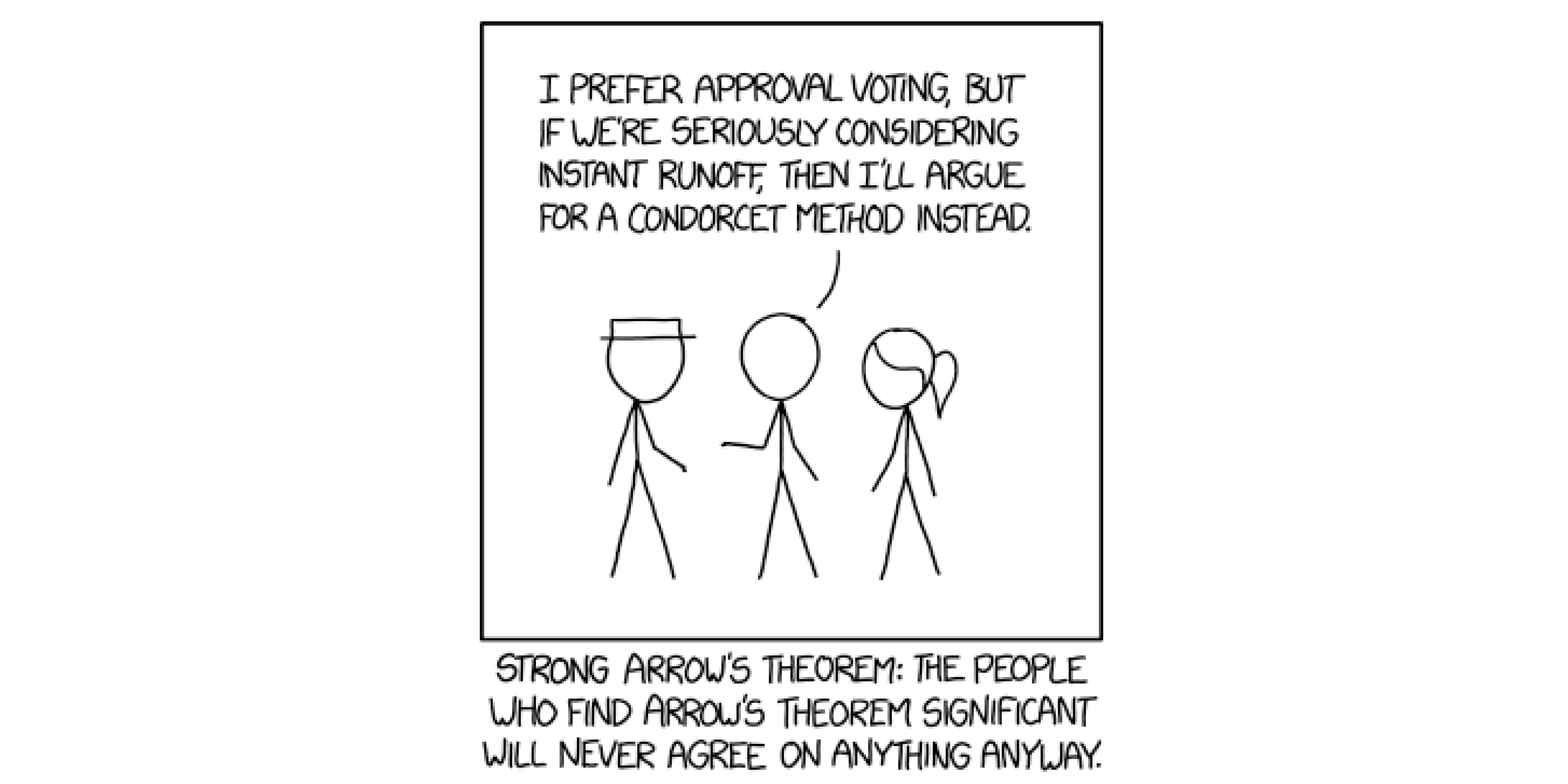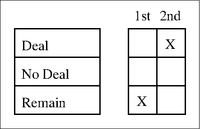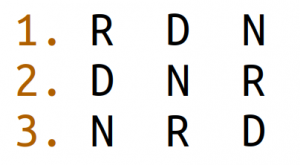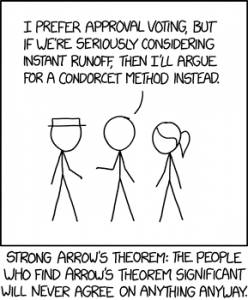A mathematical view of the will of the people
Mathematician Bernhard von Stengel uses game theory to consider how a second Brexit referendum with more than two choices could be run, and how the counting-rule chosen for any multiple-choice ballot can determine the outcome.
Picture: XKCD, via a (CC BY-NC 2.5) licence
If you favour a second referendum on Brexit (a prospect that is now, February 2019, receding), you should not only think of what you should ask the people, but how you would reconcile their choices. This is a central question of Mathematical Social Choice, with attempts to answer it since the middle ages (which is discussed in the ‘History’ section later in this post).
The question becomes interesting when there are more than two choices on the ballot paper. Suppose the choices are:
- D = leave the EU with a negotiated Deal (also called ‘soft Brexit’),
- N = leave the EU with No Deal (a ‘hard Brexit’), or
- R = Remain in the EU.
Every voter is given a first and second choice which represents their most and second-most preferred outcome. An example of a ballot is here:
On this ballot, the voter has expressed their choice as 1. R (Remain) and 2. D (Deal) with No Deal as the implicit third choice.
Assume we have 9 voters (or equal-sized voting groups) who have the following preferences:
Here, the first 4 columns are Remain voters whose preference is 1. Remain, 2. Deal, 3. No Deal. The next 3 columns are ‘Hard Brexiters’ whose preference is exactly the reverse. The last 2 columns are voters whose first preference is Deal, with one of them having Remain as their second choice, the other No Deal as second choice.
These preferences and their distribution are not unrealistic.
A voting rule now tells us how to distill ‘the will of the people’ from these preferences. But which rule should we choose? There are several contenders for such a rule.
Plurality, also called ‘first-past-the-post’
This declares as winner the option that has gotten the most first-choice votes (so one does not even need a second choice and the ballot paper is simpler). In parliamentary elections in the UK, the MP representing a constituency is chosen in this way. Here the most first-choice votes (4 out of 9) are for Remain, but this is not a majority of all votes – 5 out of 9 would rather leave the EU without or with a deal.
Supplementary vote, also called ‘Instant Runoff’
This means that the option that gets the least first votes is discarded, and the second preference of the voters who made that choice is counted (as if they would be asked to vote again in a ‘runoff’ vote, assuming that the others stay with their first choice). Here, these are the voters who chose ‘D’ and their votes are split, one of them for ‘R’ and the second for ‘N’. The total is now 5 for Remain and 4 for No Deal, and Remain is the winner as the declared ‘will of the people’ according to this rule.
The rule seems clear and fair enough, but it has its problems. The main problem is called strategic voting which means that voters have an incentive to mis-state their true preference. Namely, the minority (of people who chose ‘D’) now have in effect the casting choice between two polarised outcomes. If the above preferences were known (supported by opinion polls, say), then an ‘N’ voter as above would have an incentive to mis-state their preference instead as 1=D 2=N 3=R (that is, swap their first and second choices), to let N become the decisive minority with 2 out of 9, after D which now has 3 out of 9 first choices. The other 2 N voters would both choose D and create the final vote 4 R versus 5 D, meaning to the leave the EU with a deal. While it remains doubtful that voters are that strategic, it would, on the other hand, create an incentive to be a bit more moderate.
However, not all voting rules favour R for the above voter preferences.
Condorcet winner, or pairwise comparison
This rule looks at the stated order of preferences and compares any two outcomes with each other. That is, the preferences of the voters are now used to answer a question such as ‘do you prefer D over N’?
Here we get the following answers:
- D beats R by 5 against 4 votes
- D beats N by 6 against 3 votes
- R beats N by 5 against 4 votes
This gives the following clear collective preference: a strict majority prefers D over R, and another strict majority prefers R over N, and another strict majority prefers D over N (which does not follow from the first two, see below). Here the ‘will of the people’ is D first, R second, N third. Sounds great, but D was a first choice for only 2 out of 9 voters. Does this rule head for mediocre choices? Or for useful compromise?
The Condorcet rule has something less desirable than any of the other rules: It may not produce a clear winner but create cycles, as the following modified voter profile shows (three voters suffice):
Here, two-thirds of voters prefer R over D, two-thirds prefer D over N, and two-thirds prefer N over R. Such voter preferences may not be realistic, but who knows? The fact that they are theoretically unavoidable for any reasonable voting system is known as ‘Arrows Impossibility Theorem’, after the economist Kenneth Arrow (1921–2017).
Borda count, or giving points
Yet another voting system tries to avoid cycles by giving points for first and second choice, for example 2 points for first choice, 1 point for second choice, 0 for third choice (instead of points 2,1,0 we could also give 3,2,1 with the same effect, which is just an extra point everywhere). The option with highest total number of points wins.
In our 9-voter example, this gives points
- R = 2+2+2+2+0+0+0+1+0 = 9
- N = 0+0+0+0+2+2+2+0+1 = 7
- D = 1+1+1+1+1+1+1+2+2 = 11
which makes again D the winner. But hey, what if someone does not put an ‘X’ for their second choice at all? How should that shift the points? You get only one point for your first choice, and zero for the others? Or two points for your first choice, and zero for the others (which would surely let the Remain voters above drop their points for ‘D’ in second place).
Or we could, like in football, give 3 points for first choice, 1 point for second choice, resulting in
- R = 3+3+3+3+0+0+0+1+0 = 13
- N = 0+0+0+0+3+3+3+0+1 = 10
- D = 1+1+1+1+1+1+1+3+3 = 13
with R and D tied. But why this rule?
Some history
The Condorcet method is named after the Marquis de Condorcet (1743–1794), who died in a prison cell, poisoned, during the French Revolution. However, it was already invented in 1299 by the Majorcan polymath Ramon Llull (ca. 1232–1316). To remember that name (which has 4 letters ‘L’ in it and one vowel) think of the binary number 11011. Llull indeed invented the binary system and is considered by some as the inventor of information theory. He was so enthralled by it that he thought St Mary should be added to the Holy Trinity to make their number a power of two. Heretic stuff that did not make him popular with the church authorities. With the discovery in 2001 of his lost manuscripts, Ars notandi, Ars eleccionis, and Alia ars eleccionis, Llull is given credit for discovering the Borda count (re-discovered several times in later centuries) and the Condorcet criterion.
A very accessible book for general readers on these problems is Szpiro’s ‘Numbers Rule: The Vexing Mathematics of Democracy, from Plato to the Present’.
Conclusion
One conclusion is that you probably shouldn’t put more than two options on a ballot paper, or maybe not hold a referendum in the first place. On what voting system should you agree even to determine the ‘will of the people’, when we have enough trouble to determine it when they made one out of two choices? At any rate, you will appreciate ‘Strong Arrow’s Theorem’ from the geeky cartoon XKCD (one of my favourites):
The post gives the views of its author, not the position of Democratic Audit. It was first published on LSE Department of Mathematics’ Research blog.
About the author
 Bernhard von Stengel is a Professor of Mathematics at the London School of Economics. He teaches discrete mathematics, optimisation and game theory at LSE. He is also on Twitter – @bvonstengel.
Bernhard von Stengel is a Professor of Mathematics at the London School of Economics. He teaches discrete mathematics, optimisation and game theory at LSE. He is also on Twitter – @bvonstengel.










 Democratic Audit's core funding is provided by the Joseph Rowntree Charitable Trust. Additional funding is provided by the London School of Economics.
Democratic Audit's core funding is provided by the Joseph Rowntree Charitable Trust. Additional funding is provided by the London School of Economics.
Yes indeed, you just have to keep trying to look for ways to overturn the first vote…wrap it up in all sorts of fancy packaging, but at all costs overturn the democratic vote of June 2016. And of course if that doesn’t work, and the voters still disobey their masters on a 2nd vote, then find another way and order them to keep voting until they give the result that the elite want. What a great way of giving credibility to democracy in the eyes of the voter…
All quite interesting, but does this miss a new model called D21, where people have a top preference, a second preference and then a negative preference… so could be Remain= +2, Deal= +1, no deal = -1
How would that be considered based on your experience?
See the Janecek (Democracy 21) explanation here:
https://en.d21.me/
Apologies… I think I misrepresented this… all votes would have equal size, and you have 2 positive votes for each negative vote… so it would be Remain= +1, Deal = +1, No Deal = -1… etc
https://www.ifd21.org/en/janecek-method
Interesting!
I know it’s not the aim of the article but :
Soft Brexit – is staying in customs union (CU) (+ maybe Single Market)
Hard brexit – leaving the CU and SM and other (that is May’s deal)
No deal will have catastrophic consequeunces in the short to medium term.
It is upsetting/dangerous that no deal has been normalized to such an extent.
NO DEAL != HARD BREXIT